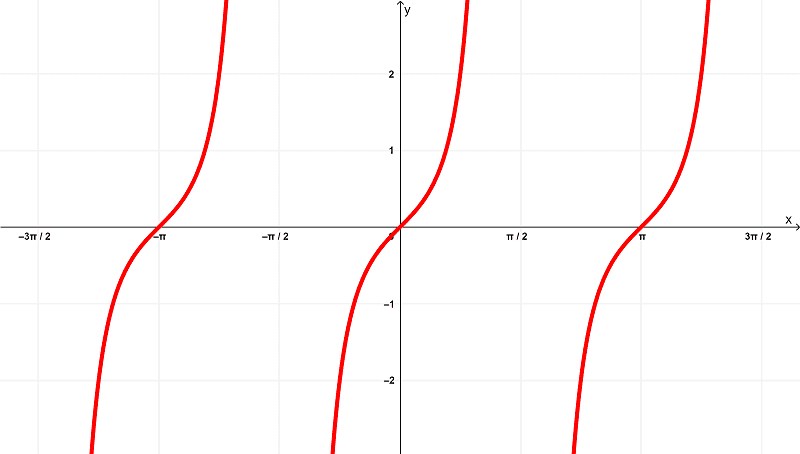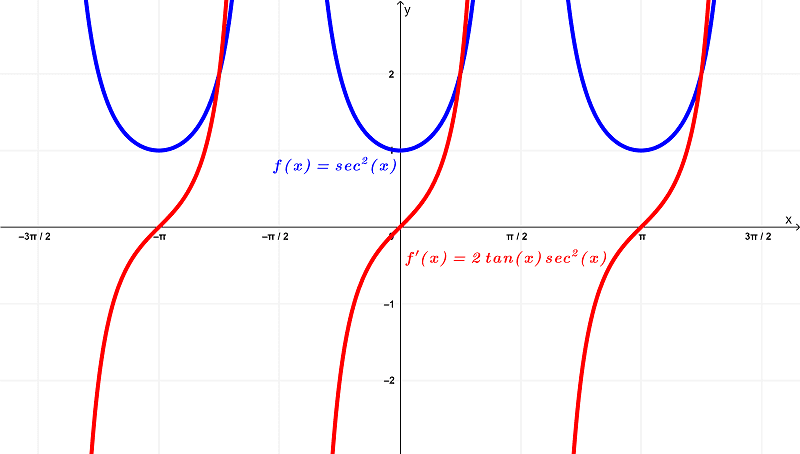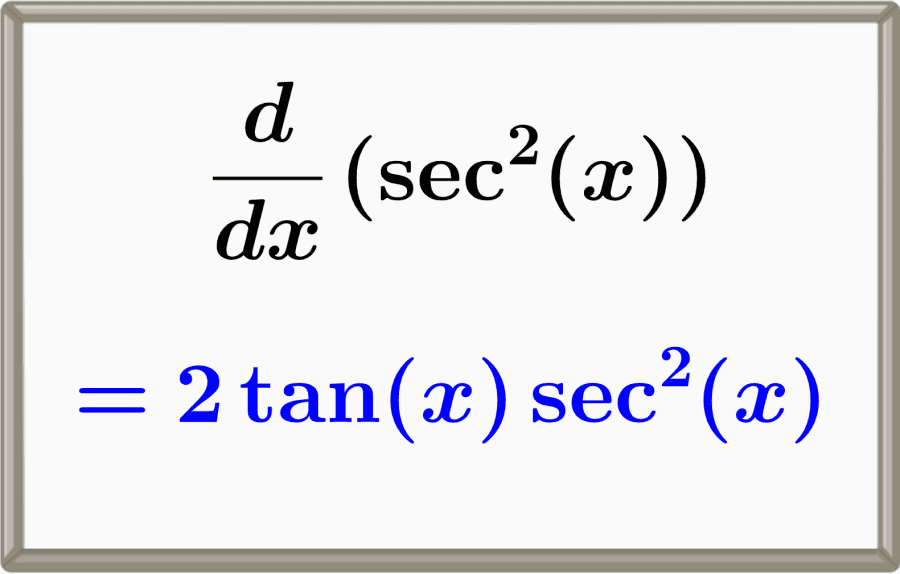The derivative of secant squared is equal to two times tangent times secant squared, 2tan(x)sec2(x). This derivative can be found by using the chain rule and the derivatives of the fundamental trigonometric functions.
Here, we will learn how to derive the secant squared function, we will look at the graphical comparison of the secant squared and its derivative, and we will solve some exercises.
Proof of The Derivative of Secant Squared Function
As a prerequisite, please review the chain rule formula and its proof by looking here: Chain Rule of derivatives. Similarly, you can review the proof of the derivative of secant function by visiting this link: Derivative of Secant, sec(x).
Please be reminded that
$latex \sec^{2}{(x)} \neq \sec{(x^2)}$
We can identify the two functions that make up F(x). There is a power function and a trigonometric function in this scenario. To be more exact, it is a function raised to a power of two and a trigonometric function of secant, based on our given F(x).
For a better representation, we can rewrite it as
$latex F(x) = \sec^{2}{(x)}$
We can identify the two functions that make up F(x). There is a power function and a trigonometric function in this scenario. To be more exact, these are a function raised to a power of two and a trigonometric function of secant, based on our given F(x).
For a better representation, we can rewrite it as
$latex F(x) = \sec^{2}{(x)}$
$latex F(x) = (\sec{(x)})^2$
It becomes evident that the given power function is the outer function to be considered, while the secant function, being raised by the given power function, is the inner function. We can configure the outer function as follows:
$latex f(u) = u^2$
where
$latex u = \sec{(x)}$
The trigonometric secant function, as the inner function of f(u), will be denoted as g(x).
$latex f(u) = f(g(x))$
$latex u = g(x)$
$latex g(x) = \sec{(x)}$
Deriving the outer function f(u) using the power rule in terms of u, we have
$latex f(u) = u^2$
$latex f'(u) = 2u$
Deriving the inner function g(x) using the derivative formula of trigonometric function secant in terms of x, we have
$latex g(x) = \sec{(x)}$
$latex g'(x) = \sec{(x)}\tan{(x)}$
Algebraically multiplying the derivative of outer function $latex f'(u)$ by the derivative of inner function $latex g'(x)$, we have
$latex \frac{dy}{dx} = f'(u) \cdot g'(x)$
$latex \frac{dy}{dx} = (2u) \cdot (\sec{(x)}\tan{(x)})$
Substituting u into f'(u), we have
$latex \frac{dy}{dx} = (2(\sec{(x)})) \cdot (\sec{(x)}\tan{(x)})$
$latex \frac{dy}{dx} = 2\sec^{2}{(x)} \cdot \tan{(x)}$
which brings us to the derivative formula of secant squared x
$latex \frac{d}{dx} \sec^{2}{(x)} = 2\tan{(x)}\sec^{2}{(x)}$
Why are the derivative of secant squared and tangent squared the same?
You may wonder why
$latex \sec^{2}{(x)}$
and
$latex \tan^{2}{(x)}$
have similar derivatives.
Recall that the Pythagorean identity for secants and tangents is
$latex \sec^{2}{(x)} = 1 + \tan^{2}{(x)}$
Then, we can derive both sides of this equation to obtain:
$latex \frac{d}{dx} (\sec^{2}{(x)}) = \frac{d}{dx}(1) + \frac{d}{dx}(\tan^{2}{(x)})$
The derivative of a constant is equal to zero, so:
$latex \frac{d}{dx} (\sec^{2}{(x)}) = 0 + \frac{d}{dx}(\tan^{2}{(x)})$
$latex \frac{d}{dx} (\sec^{2}{(x)}) = \frac{d}{dx}(\tan^{2}{(x)})$
This is why both the secant squared and the tangent squared have the same derivative, because of the Pythagorean formula for secants and tangents.
Graph of Secant Squared x VS. The Derivative of Secant Squared x
With the function
$latex f(x) = \sec^{2}{(x)}$
it is graphed as

If we derive the function $latex f(x) = \sec^{2}{(x)}$, we have
$latex f'(x) = 2\tan{(x)}\sec^{2}{(x)}$
and its graph is

Illustrating both graphs in one, we have

By examining these graphs, it can be seen that the original function $latex f(x) = \sec^{2}{(x)}$ has a domain of
$latex \left(-\frac{3\pi}{2},-\frac{\pi}{2}\right) \cup \left(-\frac{\pi}{2},\frac{\pi}{2}\right) \cup \left(\frac{\pi}{2},\frac{3\pi}{2}\right)$
within the finite intervals of
$latex \left(-\frac{3\pi}{2},\frac{3\pi}{2}\right)$
and lies within the range of
$latex [1,\infty)$
whereas the derivative $latex f'(x) = 2\tan{(x)}\sec^{2}{(x)}$ has a domain of
$latex \left(-\frac{3\pi}{2},-\frac{\pi}{2}\right) \cup \left(-\frac{\pi}{2},\frac{\pi}{2}\right) \cup \left(\frac{\pi}{2},\frac{3\pi}{2}\right)$
within the finite intervals of
$latex \left(-\frac{3\pi}{2},\frac{3\pi}{2}\right)$
and lies within the range of
$latex (-\infty,\infty)$
Examples
In the following examples, we can learn how to derive composite secant squared functions.
EXAMPLE 1
What is the derivative of the function $latex f(x) = \sec^2(8x)$?
Solution
Since we have a composite function, let’s use the chain rule to derive it.
Therefore, the function $latex u=8x$ can be considered as the inner function. This means that we have $latex f(u)=\tan^2(u)$.
Using the chain rule with these functions, we have:
$$\frac{dy}{dx}=\frac{dy}{du} \frac{du}{dx}$$
$$\frac{dy}{dx}=2\tan(u)\sec^2(u) \times 8$$
Finally, we make the substitution $latex u=8x$ and we have:
$$\frac{dy}{dx}=16\tan(8x)\sec^2(8x)$$
EXAMPLE 2
Determine the derivative of the function $latex F(x) = \sec^2(5x^3-4x)$.
Solution
This function can also be derived using the chain rule, where $latex u=5x^3-4x$ is the inner function.
Therefore, the outer function is $latex f (u) = \sec^2(u)$ and its derivative is:
$$\frac{d}{du} ( \sec^2(u) ) = 2\tan(u)\sec^2(u)$$
Now, we calculate the derivative of the inner function $latex g(x)=u=5x^3-4x$:
$$\frac{d}{dx}(g(x)) = \frac{d}{dx}(5x^3-4x)$$
$$\frac{d}{dx}(g(x)) = 15x^2-4$$
Then, we multiply the derivative of the outer function $latex f(u)$ by the derivative of the inner function $latex g(x)$:
$$\frac{dy}{dx} = \frac{d}{du} (f(u)) \cdot \frac{d}{dx} (g(x))$$
$$\frac{dy}{dx} = 2\tan(u)\sec^2(u) \cdot (15x^2-4)$$
Finally, we make the substitution $latex u=5x^3-4x$ and simplify:
$$\frac{dy}{dx} = 2\tan(5x^3-4x)\sec^2(5x^3-4x) \cdot (15x^2-4)$$
$$\frac{dy}{dx} = (30x^2-8)\tan(5x^3-4x)\sec^2(5x^3-4x)$$
Practice of derivatives of secant squared functions


See also
Interested in learning more about the derivatives of trigonometric functions squared? Take a look at these pages:
- Derivative of Cosine Squared, cos^2(x) with Proof and Graphs
- Derivative of Sine Squared, sin^2(x) with Proof and Graphs
- Derivative of Tangent Squared, tan^2(x) with Proof and Graphs
- Derivative of Cosecant Squared, csc^2(x) with Proof and Graphs
- Derivative of Cotangent Squared, cot^2(x) with Proof and Graphs




